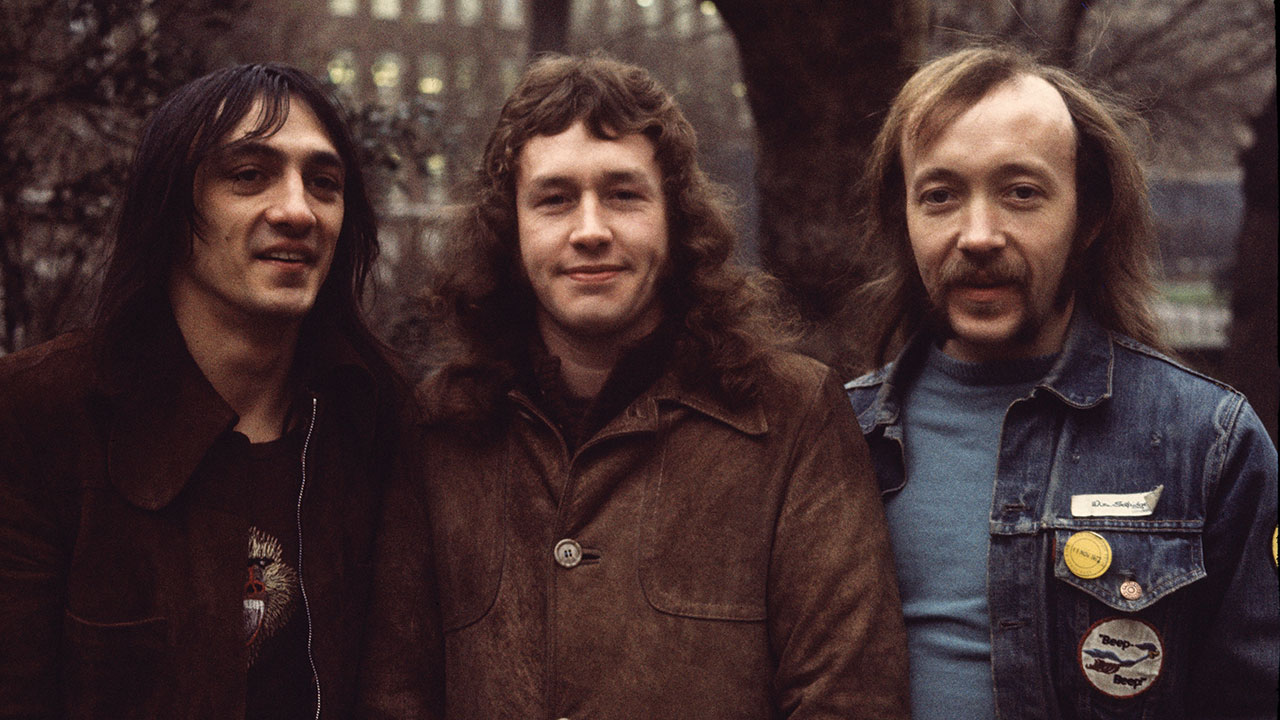They helped to spearhead the British blues boom before taking a turn into rock’s left-field for a quartet of classic albums. They bolstered their sound with Mellotron and synth. They even recruited the drummer from Egg. In 2020 Prog asked the late Tony McPhee: how prog were The Groundhogs?
Formed in 1963, and part of the first wave of the British blues boom, the Groundhogs initially came to public attention as John Lee Hooker’s backing band when the veteran bluesman paid a visit to the UK in 1964. More gigs followed with Jimmy Reed and Champion Jack Dupree, and in 1968 they were signed to Liberty Records by future Wombles supremo Mike Batt. However, it wasn’t long before the band were embracing the new progressive aesthetic with their 1969 album, Blues Obituary, proclaiming in no uncertain terms a move away from blues purism towards a more experimental direction.
The Groundhogs are a classic example of a band who incorporated progressive elements into their music while retaining their core sound; a process that was rife in the early 1970s. Think of hard rock’s big three at the time – Led Zeppelin, Deep Purple and Black Sabbath – and then consider Stairway To Heaven, Child In Time and Wheels Of Confusion.
But under the leadership of singer and guitarist Tony McPhee, the Groundhogs pushed out further than most. In particular, the four albums they recorded between 1970 and 1972 – Thank Christ For The Bomb, Split, Who Will Save The World? and Hogwash – saw them becoming increasingly ambitious, both compositionally and conceptually, with the deployment of Mellotron and synth helping to create an exciting progressive/blues rock hybrid.
Looking back, McPhee isn’t entirely sure how the progressive influence seeped in: “As a jobbing musician, there was little time to follow others,” he says. ”We were gigging constantly, so if it wasn’t on the car radio, we hardly got to hear it.” But he was determined to move the Groundhogs forward: “I’ve always liked going in new directions away from ‘the crowd’ – the blues can be limiting to an extent, and I wanted to explore.”
Operating as a power trio of McPhee, bassist Pete Cruickshank and drummer Ken Pustelnik, the band were determined to make a statement with their 1970 album. “The title came from a discussion with Roy Fisher, Groundhogs’ manager at the time. John Lennon had said that The Beatles were bigger than Jesus and got a lot of publicity, so we were trying to think of something that was as contentious as that. Roy said, ‘Thank Christ for the bomb,’ and it all clicked in my head.”
McPhee set about writing a set of songs full of contrasting riffs and chords – still recognisably blues rock, but skewed into dynamic new shapes. The lyrics were also a major advance from traditional rock’n’roll platitudes; the first side of the album is based around the theme of alienation, while the second tells the story of a rich man who renounces his status and embraces poverty instead.
Soldier deftly portrays the brutalising effects of war, set to an irresistibly catchy riff: “We really got our boost when John Peel played Soldier on his programme, he liked the song and the lyrical complexity.”
Thank Christ For The Bomb got to No.9 in the UK charts, and significantly raised the Groundhogs’ profile. They started playing alongside many of the era’s emerging prog bands, including Yes, Curved Air, Gentle Giant and Colosseum – although McPhee admits: “I wasn’t enamoured by some of the bands in the progressive scene at that time. I didn’t like the soft, fluffy sound that they produced.” Instead, he drew inspiration from the darker, edgier sounds of groups such as King Crimson.
The Groundhogs were one of the coterie of underground bands on the Liberty/United Artists roster, which included Hawkwind, Man, Can and Amon Düül II. McPhee remembers an incident at a festival in Hamburg: “We opened the van and much to our surprise, it was filled with a load of Orange gear, which wasn’t ours. The record company had bought it for Amon Düül II because VAT was cheaper in the UK than in Germany.
”They came and whisked it away; but when they played, they overran their time slot so much that the Groundhogs didn’t get to play. Not only had we unknowingly acted as a free taxi for their gear, but we’d driven all the way to Hamburg without playing the gig!”
A lot of fans and the press didn’t like it… I agreed with them for a while
The first side, and four-part title track, of their 1971 album Split was another conceptual piece, this time focused on mental breakdown and schizophrenia. The lyrics were based on a frightening experience McPhee himself had lived through. Having previously smoked cannabis to no ill effect, he recalls politely accepting a joint: “It was the start of a nightmare.
“I suffered what I now call my ‘aberration.’ The day had been hot and I’d got burnt in the park – a mix of heatstroke and cannabis led to a month of terror and confusion. Writing about it probably helped work my way through it, although I got anxiety flashbacks for a long time afterwards. I never touched drugs again.”
Building on their popularity as an explosive live act, and coming off the back of opening for the Rolling Stones on their 1971 UK tour, Split was the Groundhogs’ most successful album, peaking at No.5 in the UK charts. Another set of spiky, twisting songs, it includes their most well-known track, the punk blues stomp of Cherry Red – from where the record label takes its name – which, despite not being released as a single, even secured them a slot on Top Of The Pops. But McPhee had higher aspirations in mind.
Who Will Save The World? is where their prog inclinations really became apparent – just listen to the jazzy riffs and dramatic Mellotron of Earth Is Not Room Enough and Music Is The Food Of Thought. It’s another loosely conceptual album, addressing the various evils threatening the world – overpopulation, war, big business…
But its presentation was anything but po-faced, with DC and Marvel Comics’ artist Neal Adams brought in to create a fold-down comic strip sleeve, with the band reimagined as superhero troup The Mighty Groundhogs. “I was a big fan of Silver Surfer, as drawn by Neal,” says McPhee. “Once I saw the artwork he’d come up with, I wanted to write all the songs to link with it.”
Despite getting to No.8 in the UK charts, it got a decidedly frosty reception compared to their previous albums. “A lot of fans and the press didn’t like it. To be honest, it was rushed – I never had the time to work on the production or even think about what we were playing, and I agreed with them for a while.
”It was only a few years later, when I could listen to it objectively, that I realised its strengths. Now we often get people saying it’s their favourite album.”
He continued to take the band in a more progressive direction, adding an ARP 2600 synthesiser to their musical armoury. And following the departure of Pustelnik, the band’s new drummer was none other than Clive Brooks from Canterbury scene stalwarts Egg, who had supported the Groundhogs on tour.
“Clive was a lovely man and there was a lot less stress involved with getting together on time, playing and touring,” says McPhee. “He was a powerful player who suited the times and the new material I was writing.”
That material would emerge on the brilliant Hogwash, the band’s most overtly progressive album. Not only are Mellotron and synth more to the fore than ever – in particular on You Had A Lesson and Earth Shanty – but the clever arrangements and segues between songs make for a genuinely sophisticated and powerful listening experience.
McPhee’s lyrics are also some of his most challenging. For instance, opener I Love Miss Ogyny is a chilling depiction of domestic abuse from the point of view of the abuser, the song’s stop-start dynamic reflecting its dysfunctional theme.
There are still a lot of arrogant people who get a kick out of cruelty
Alas, the public weren’t receptive to McPhee’s increasingly outré take on blues rock, and Hogwash failed to chart. It also proved to be their last album for United Artists, with the band signing to WWA, the short-lived label set up by Black Sabbath’s management team. They released the album Solid in 1974 – which, as the name suggests, was a retreat from the more expansive sound of Hogwash – before splitting up for the first time the following year.
Before that had come the apogee of McPhee’s experimental impulses, with the 1973 release of his first solo album, The Two Sides Of Tony (T.S.) McPhee. On one side was a collection of folk blues numbers, and on the other an avant-garde electronic symphony entitled The Hunt, performed on the ARP 2600 and a Rhythm Ace drum machine, which still sounds completely out there today.
“I’d been using the ARP 2600 during gigs for the Hogwash tour and wanted to explore its potential,” he recalls. ”It also gave me an opportunity to express my loathing for people who hunt foxes. I stand by what I said then – there are still a lot of arrogant people who get a kick out of cruelty.”
The Groundhogs may have existed on the periphery of the prog world, but the way the genre informed their music in the early 70s is a fascinating example of cultural cross-fertilisation.
And while they never quite made it into rock’s premier league, they released some of the era’s most innovative and exciting albums – and they retain a devoted fanbase to this day, with their better-known admirers including Captain Sensible, Julian Cope, Pavement’s Stephen Malkmus, QOTSA’s Josh Homme and Underworld’s Karl Hyde.
Fire Records are keeping the band’s legacy alive with an ongoing reissue programme of their classic Liberty/UA albums, in full consultation with McPhee. With any luck, a new generation of fans might discover one of the most distinctive bands that Britain has ever produced. As he humbly concludes: “It’s gratifying to think that people regard the music as still being relevant.”





